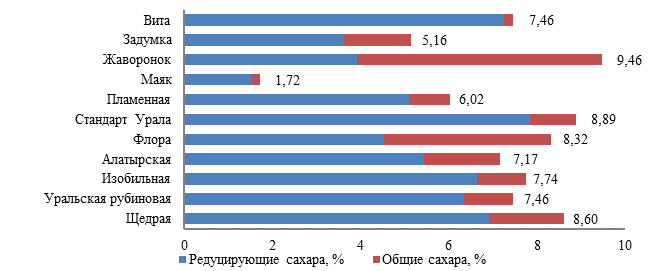STUDY OF ANTIOXIDANT INDICATORS OF CHERRY FRUIT VARIETIES ZONED IN SVERDLOVSK REGION
UDC 641.5
Abstract
The article presents the results of a study of 11 varieties of cherry fruits released in the Sverdlovsk region. As a result of studies of antioxidant indicators, the highest values of antioxidant activity were, mmol/l equiv: in the period of early maturation – variety "Zadumka" – 31.995; in the period of medium ripening – the variety "Standard of the Urals" – 24.457; in the period of late ripening - variety "Alatyrskaya" – 30.610; the lowest value of the studied indicator in the variety "Flaming" – 7.799. At the same time, the highest content of flavonoids is observed in such varieties of cherry fruits as, mg / 100 g of the edible part, the "Zadumka" variety – 147.0±4.4, the “Ural Standard” variety – 112.4±3.4 and the variety "Alatyrskaya" – 140.6±4.2; the highest content of anthocyanins is observed in such varieties of cherry fruits as, mg cyanidin-3-glycoside / 100 g of edible part, variety "Zadumka" – 650.0±19.5, variety "Ural Standard" – 702.6±21.1 and promising variety "13-24" – 692.1±20.8; the highest content of phenolic substances is observed in such varieties of cherry fruits as, mg of gallic acid / 100 g of edible part, variety "Zadumka" – 51.6±1.6, variety "Mayak" – 75.9±2.3 and promising variety "13-24" – 93.2±2.8.
In addition, such consumer characteristics of berries as the content of total and reducing sugars, as well as acidity, were studied. The data obtained will make it possible to more correctly calculate the nutritional value of diets and reasonably choose one or another variety for dietary correction of the diet in order to increase the overall antioxidant activity.
Downloads
Metrics
References
Akimov M.Yu., Makarov V.N., Zhbanova Ye.V. Dostizheniya nauki i tekhniki APK, 2019, vol. 33, no. 2, pp. 56–60. DOI: 10.24411/0235-2451-2019-10214. (in Russ.).
Makarova N.V., Dmitriyeva A.N., Musifullina E.V., Stryukova A.D., Sobolev G.I., Antipenko M.I., Azarov O.I. Pishchevaya promyshlennost', 2013, no. 4, pp. 25–27. (in Russ.).
Dziadek K., Kopeć A., Tabaszewska M. European Food Research and Technology, 2019, vol. 245, pp. 763–772. DOI: 10.1007/s00217-018-3198-x.
Bykova T.O., Aleksashina S.A., Demidova A.V., Makarova N.V., Demenina L.G. Izvestiya VUZov. Pishchevaya tekhnologiya, 2017, no. 1, pp. 32–35. (in Russ.).
Lee K.-W., Je H., Jung T.-H., Lee Y., Choi J.-H., Hwang H.-J., Shin K.-O. The Korean Journal of Food And Nutri-tion, 2018, vol. 31, no. 5, pp. 729–736. DOI: 10.9799/KSFAN.2018.31.5.729.
Jiroutova P., Kovalikova Z., Toman J., Dobrovolna D., Andrys R. International Journal of Molecular Sciences, 2021, vol. 22, no. 15, pp. 7922–7937. DOI: 10.3390/ijms22157922.
Chugunova O.V., Zavorokhina N.V., Vyatkin A.V. Agrarnyy vestnik Urala, 2019, no. 11(190), pp. 59–64. DOI: 10.32417/article_5всв861у8у0053.57240026. (in Russ.).
Akimov M.Yг., Bessonov V.V., Kodentsova V.M., Eller K.I., Vrzhesinskaya O.A., Beketova N.A., Kosheleva O.V., Bogachuk M.N., Malinkin A.D., Makarenko M.A., Shevyakova L.V., Perova I.B., Rylina Ye.V., Makarov V.N., Zhidekhina T.V., Kol'tsov V.A., Yushkov A.N., Novotortsev A.A., Bryksin D.M., Khromov N.V. Voprosy pitaniya, 2020, vol. 89, no. 4, pp. 220–232. DOI: 10.24411/0042-8833-2020-10055. (in Russ.).
Srednicka-Tober D., Ponder A., Hallmann E., Głowacka A., Rozpara E. Antioxidants, 2019, vol. 8, no. 11, pp. 534–548. DOI: 10.3390/antiox8110534.
Vyatkin A.V., Pastushkova Ye.V., Feofilaktova O.V. Sovremennaya nauka i innovatsii, 2018, no. 1(21), pp. 58–66. (in Russ.).
Galsanova I.Ts. Aktual'nyye voprosy farmatsevticheskikh i yestestvennykh nauk, 2021, pp. 133–136. (in Russ.).
Tarasov A.V., Chugunova O.V., Stozhko N.Yu. Industriya pitaniya, 2020, vol. 5, no. 3, pp. 85–96. DOI: 10.29141/2500-1922-2020-5-3-10. (in Russ.).
Demidova A.V., Makarova N.V. Pishchevaya promyshlennost', 2016, no. 2, pp. 40–43. (in Russ.).
Yeremeyeva N.B., Makarova N.V. Voprosy pitaniya, 2016, vol. 85, no. 2, pp. 188–189. (in Russ.).
Mirto A., Iannuzzi F., Carillo P., Loredana C.F., Woodrow P., Fuggi A. Food Chemistry, 2017, vol. 15, no. 240, pp. 522–527. DOI: 10.1016/j.foodchem.2017.07.162.
Di Matteo A., Russo R., Graziani G., Ritieni A., Di Vaio C. Journal of the Science of Food and Agriculture, 2017, vol. 97, pp. 2782–2794. DOI: 10.1002/jsfa.8106.
Skrovankova S., Sumczynski D., Mlcek J., Jurikova T., Sochor J. International Journal of Molecular Sciences, 2015, vol. 16(10), pp. 24673–24706. DOI: 10.3390/ijms161024673.
Wu Q., Yaun R.-Y., Feng C.-Y., Li S.-S., Wang L.-S. Natural Product Communications, 2019, vol. 14, no. 6. DOI: 10.1177/1934578X19856509.
Deyneka L.A., Chulkov A.N., Deyneka V.I., Sorokopudov V.N., Shevchenko S.M. Nauchnyye vedomosti Belgo-rodskogo gosudarstvennogo universiteta. Seriya: Yestestvennyye nauki, 2011, no. 15-1(104), pp. 367–373. (in Russ.).
Rakhmetova T.P. Sovremennoye sadovodstvo, 2019, no. 4, pp. 65–75. (in Russ.).

Copyright (c) 2022 chemistry of plant raw material

This work is licensed under a Creative Commons Attribution 4.0 International License.

This work is licensed under a Creative Commons Attribution 4.0 International License.
The authors, which are published in this journal, agree to the following conditions:
1. Authors retain the copyright to the work and transfer to the journal the right of the first publication along with the work, at the same time licensing it under the terms of the Creative Commons Attribution License, which allows others to distribute this work with the obligatory indication of the authorship of this work and a link to the original publication in this journal .
2. The authors retain the right to enter into separate, additional contractual agreements for the non-exclusive distribution of the version of the work published by this journal (for example, to place it in the university depository or to publish it in a book), with reference to the original publication in this journal.
3. Authors are allowed to post their work on the Internet (for example, in a university repository or on their personal website) before and during the review process of this journal, as this may lead to a productive discussion, as well as more links to this published work.











